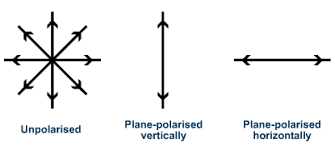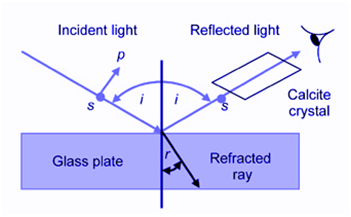Polarization, Plane PolarizedLight Brewster’s Law, Uses of Plane PolarizedLight and Polaroids
Polarizing is the transformation of unpolarized light to the polarized light. In the unpolarized light, the particles are vibrating in the different planes. The unpolarized light can be polarized by the use of polaroid, scattering and refraction and reflection.

The scattered light that is in the perpendicular direction to the incident ray’s direction is completely polarized, while the light that passes through the molecules is partially polarized. Every polaroid is having a pass axis, and the passage of light is only allowed through the pass axis.
Brewster’s Law
According to this law at the particular angle of incidence, there is a complete polarization of the reflected ray and the angle between the refracted ray and reflected ray is 90 degrees. This law is a relationship for the light waves.

The polarization angle is known as Brewster’s angle. It is the angle of incidence at which the light ray is having p-polarization, that is transmitted through the dielectric surfaces which are transparent and there is no happening of reflection. The unpolarized light at this specific angle is transmitted and the reflection of light is from the surface.
Uses
- The polaroid films are commonly used for reducing the glare of sunshine in brighter settings. When the light is reflected from water, then it is partially polarized, and polaroid films are used as filters, for photographing the water bodies, or when the photographing objects are located beneath the water.
- The polaroid is also used in the spectacles, for reducing the amount of glare. Their use in the night driving goggles is extremely important due to their ability to filter out the partially polarized light that is reflected off from the windshield.
- In various chemical analysis plane, polarized light is used for the determination of handedness or chirality of the molecules. When this light is passing through the solution that is containing chiral molecules, then there is a rotation of the plane of polarization by the particular angle. The angle of rotation in the solution can be determined, and in this way, the purity of products that can be obtained from the chemical reaction can also be determined.
- The plane-polarized light also has significant use for producing the circularly polarized light. In such cases, there is a rotation of the electric vector, followed by the propagation. The light can also be polarized circularly, by the introduction of phase shift, using the birefringent material.